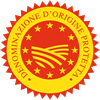Description
The Aglio Bianco Polesano PDO refers to dried garlic belonging to the Allium sativum L. species, Avorio variety, deriving from the local Bianco Polesano ecotype.
Production Area
The production area of Aglio Bianco Polesano PDO is within 29 municipalities in the Province of Rovigo, in the Veneto region.
Production Method
Annual crop rotation is practiced and the garlic cannot be replanted in the same soil for an interval of 3 years. Sowing can be carried out manually or mechanically between October 1st and December 31st. The start of the harvest is decided by the producer, who assesses the level of ripeness of the bulb. Harvesting can be carried out manually or mechanically, with either a clean cut of the stalk, which is completely removed from the root, or by leaving just the apical bud. The bulbs are then dried naturally or with heated ventilation systems. During packaging, the bulbs are hand-woven together with their stalks and bound with string, raffia or other suitable materials.
Appearance and Flavour
Aglio Bianco Polesano PDO has a regular roundish shape with a slightly flat base; it is bright white in colour, without any coloured streaks. The bulbs are perfectly adjacent to each other and form a compact structure. The aroma is unique, less pungent and more persistent than other varieties, with pleasant hints of freshly cut grass and a sweet fruity aroma.
History
The presence of garlic in the Polesine area dates back to the Romans, who substantially changed the hydro-geologic conformation of the area thanks to the reclamation and recovery of agricultural land. The garlic crop was one of the most widely spread at that time, so much so, that Vergil mentioned it in the Georgics. Later, in the Middle Ages, Bocchi wrote in the Annali Pollicinensi that the inhabitants of Rovigo were forced to cultivate l’alio loco bono (good local garlic) on their plots of land. In the XVI century, books from the Accademia dei Concordi Rovigo mention garlic production as a particularly important activity in the area. In the mid XX century, garlic was already considered an industrial cultivation, so much so, that it earned the name “white gold of Polesine” for its commercial importance.
Gastronomy
Aglio Bianco Polesano PDO must be kept in a cool, dry and airy place, and is best left with its tassels. When eaten fresh, its organoleptic characteristics and beneficial properties remain unaltered. When cooked, it is an ideal ingredient for enhancing the flavour of many dishes: from simple spaghetti with garlic, oil and chili, to more elaborated dishes such as soups, sauces or stews.
Marketing
The product is marketed as Aglio Bianco Polesano PDO. It is put on the market between July 10th and July 9th of the year following the harvest. It is sold in baskets (3-5 bulbs) or bunches with a varying amount of bulbs, weighing 0,5 and 2 kg; braids (5-22 bulbs) and large braids (30-40 bulbs), bunches (20-40 bulbs) and large bunches (70-120 bulbs), with a total weight ranging from 0.35 to 20 kg; 50 to 1000 g packets are also available, as well as 1 to 20 kg bags containing a variable amount of bulbs. Wood or plastic cartons or other suitable materials are used for packaging. The commercial categories are: Extra (minimum size 30 mm) and First (minimum size 45 mm).
Distinctive Features
Aglio Bianco Polesano PDO is characterised by its particular aroma, which is given to the combination of volatile sulphur compounds and aromatic substances present in the bulb.




















